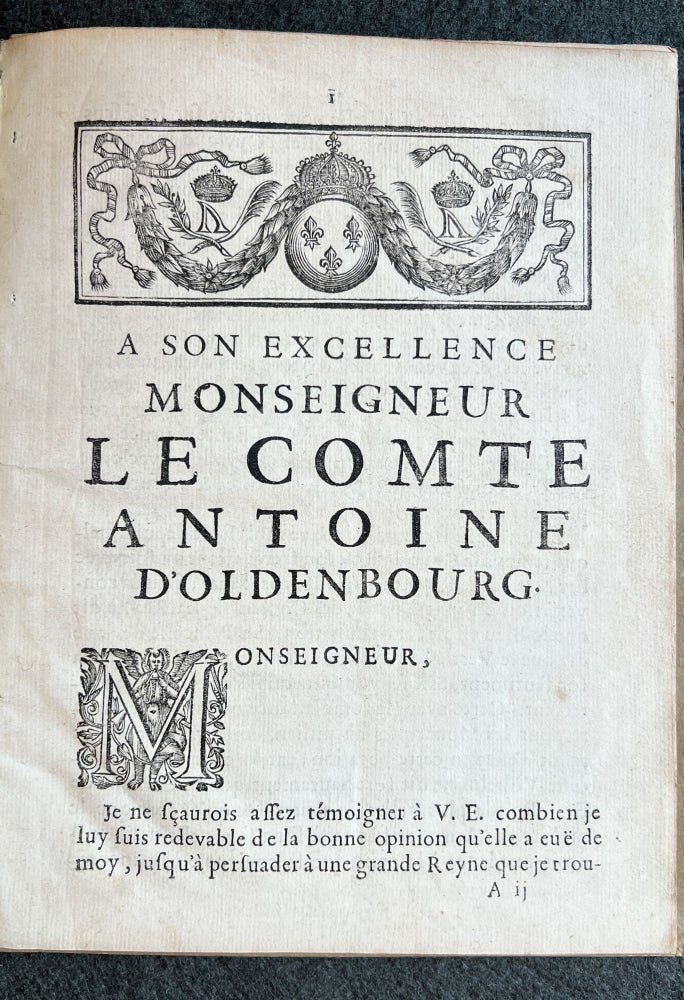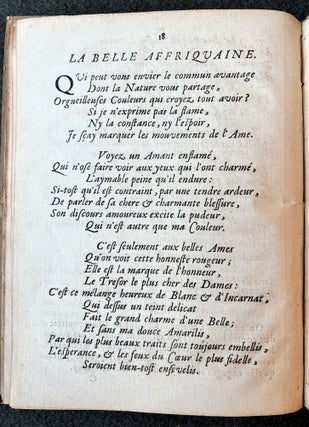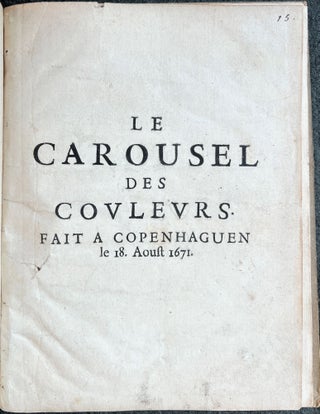Le Carousel des couleurs. Fait a Copenhaguen le 18 Aoust 1671. [Copenhagen?, 1671].
4to (217 x 166 mm). Half-title; woodcut headpiece with crowns and fleurs-de-lys, woodcut initial. A modest copy, staining, soiling to half title, small internal tears at gutter. Modern boards (worn). Removed from a collected volume, early manuscript number (15) on front flyleaf. ***
Only edition of an account of a color-themed tournament, held at the Danish court by King Christian V and the royal family. Most interesting is the pre-modern concept of colors expressed in this pamphlet.
The tournament was inspired by a casual discussion of favorite colors, by the recently crowned King, his Queen, the pregnant Charlotte Amalie of Hesse-Kassel (not yet showing, notes the author), and three Princesses: the Princess Zweibrücken (”de deux Ponts”), and the King’s sisters Wilhelmina Ernestine von Oldenburg and Anna Sophia, Electoral Princess of Saxony, visiting from Dresden. Organized quickly, the tournament was held in the royal riding stables “on a beautiful day, at four in the afternoon.” The four competing colors were Green (the choice of Anna-Sophia, supported by the King), Blue (the Queen’s selection), the Color of Fire (defended by Princess Wilhelmina), and “Amaryllis, the Color of Skin” (chosen by the Princess Zweibrücken). From the descriptions and poems it becomes clear that green represents plants and living things, blue the celestial spheres and largesse, the color of fire stands in for the sun, passion, fame and triumph, and amaryllis or the shade of skin — which flickers between dark rose, pale rose, and black — symbolizes beauty, freshness, modesty and youth. Each color is defended by its princess and her chosen chevalier, who himself chooses a second, and each is represented by an allegorical figure or goddess: Diana stands in for green, Generosity blue, Fame the color of fire, and “the Beautiful African” represents amaryllis. Each of these figures recites a poetic manifesto. The writer dwells on the participants’ splendid garments and the matching caparisons of their mounts, their tilting games and displays of horsemanship. They must have been quite a sight: the Princess of Saxony, her knight and his mount bedecked in green openwork brocade over silver, her dress further glittering with pearls and emeralds; the Queen’s team in blue, with “a thousand turquoises surrounded by diamonds sparkling on her person”; Princess Wilhelmina in a fire-colored corset embroidered in gold with scales of silver, and rubies and diamonds around her waist; and finally the Princess Zweibrücken, whose “advantageous height” added to her magnificence, representing Africa in hues of rose and white, entering with her cortège, all in black masks.
Following the tournament, won by Green, closely followed by the Color of Fire, the final judgment is passed by the Princess Ulrika Eleonora (later Queen of Sweden), who had remained with the Queen Dowager rather than participating in the festival (true to the descriptions of her character as devout and disapproving of court pastimes). Representing the goddess Iris, she declares her love for all colors.
This anonymous insider’s account of idiosyncratic royal fun is dedicated to the Count Anton of Oldenburg. The last count of this name (Anton Günther) had died in 1667, leaving no heirs, and the title of Count of Oldenburg had passed to the Danish sovereign, i.e., Christian V himself (styled Christian VIII, Count of Oldenburg). As another Count of Oldenburg indeed took part in the joust, as chevalier to the Queen, he must have belonged to a different line of the vast family.
Not in the Faber Birren collection. I locate a single institutional copy, at the Bibliothèque nationale de France, bound with an apparently unrelated engraved frontispiece of the gardens of Versailles. Item #4171
No longer available



